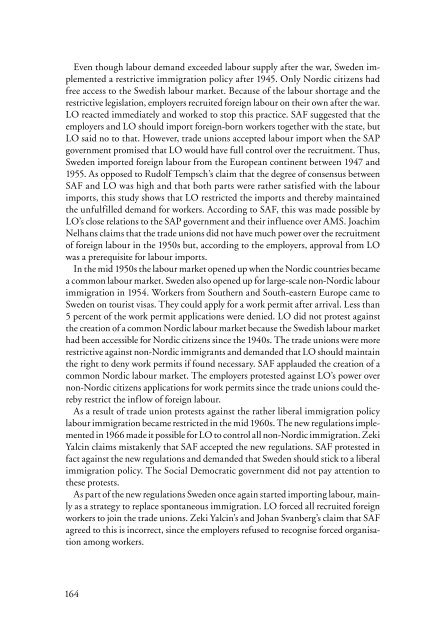gupea_2077_29098_3
gupea_2077_29098_3
gupea_2077_29098_3
Create successful ePaper yourself
Turn your PDF publications into a flip-book with our unique Google optimized e-Paper software.
Even though labour demand exceeded labour supply after the war, Sweden implemented<br />
a restrictive immigration policy after 1945. Only Nordic citizens had<br />
free access to the Swedish labour market. Because of the labour shortage and the<br />
restrictive legislation, employers recruited foreign labour on their own after the war.<br />
LO reacted immediately and worked to stop this practice. SAF suggested that the<br />
employers and LO should import foreign-born workers together with the state, but<br />
LO said no to that. However, trade unions accepted labour import when the SAP<br />
government promised that LO would have full control over the recruitment. Thus,<br />
Sweden imported foreign labour from the European continent between 1947 and<br />
1955. As opposed to Rudolf Tempsch’s claim that the degree of consensus between<br />
SAF and LO was high and that both parts were rather satisfied with the labour<br />
imports, this study shows that LO restricted the imports and thereby maintained<br />
the unfulfilled demand for workers. According to SAF, this was made possible by<br />
LO’s close relations to the SAP government and their influence over AMS. Joachim<br />
Nelhans claims that the trade unions did not have much power over the recruitment<br />
of foreign labour in the 1950s but, according to the employers, approval from LO<br />
was a prerequisite for labour imports.<br />
In the mid 1950s the labour market opened up when the Nordic countries became<br />
a common labour market. Sweden also opened up for large-scale non-Nordic labour<br />
immigration in 1954. Workers from Southern and South-eastern Europe came to<br />
Sweden on tourist visas. They could apply for a work permit after arrival. Less than<br />
5 percent of the work permit applications were denied. LO did not protest against<br />
the creation of a common Nordic labour market because the Swedish labour market<br />
had been accessible for Nordic citizens since the 1940s. The trade unions were more<br />
restrictive against non-Nordic immigrants and demanded that LO should maintain<br />
the right to deny work permits if found necessary. SAF applauded the creation of a<br />
common Nordic labour market. The employers protested against LO’s power over<br />
non-Nordic citizens applications for work permits since the trade unions could thereby<br />
restrict the inflow of foreign labour.<br />
As a result of trade union protests against the rather liberal immigration policy<br />
labour immigration became restricted in the mid 1960s. The new regulations implemented<br />
in 1966 made it possible for LO to control all non-Nordic immigration. Zeki<br />
Yalcin claims mistakenly that SAF accepted the new regulations. SAF protested in<br />
fact against the new regulations and demanded that Sweden should stick to a liberal<br />
immigration policy. The Social Democratic government did not pay attention to<br />
these protests.<br />
As part of the new regulations Sweden once again started importing labour, mainly<br />
as a strategy to replace spontaneous immigration. LO forced all recruited foreign<br />
workers to join the trade unions. Zeki Yalcin’s and Johan Svanberg’s claim that SAF<br />
agreed to this is incorrect, since the employers refused to recognise forced organisation<br />
among workers.<br />
164


